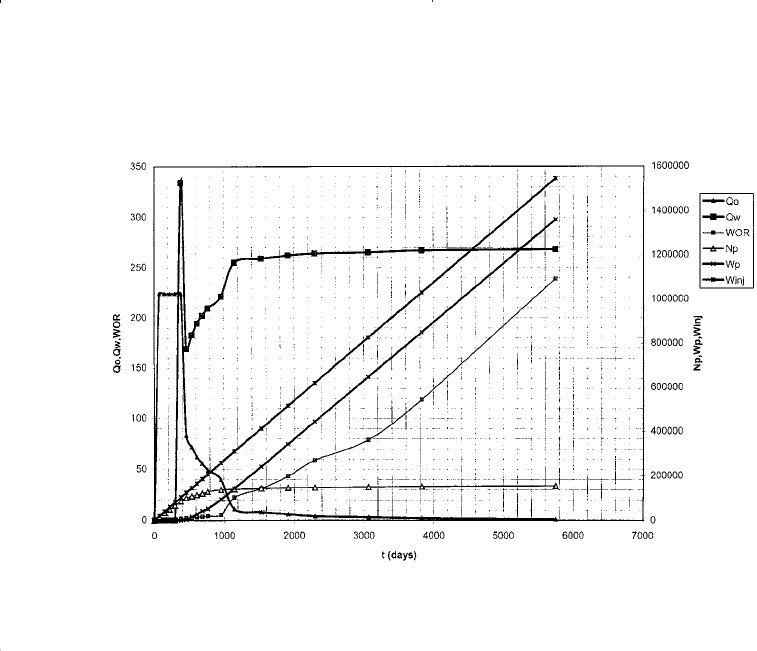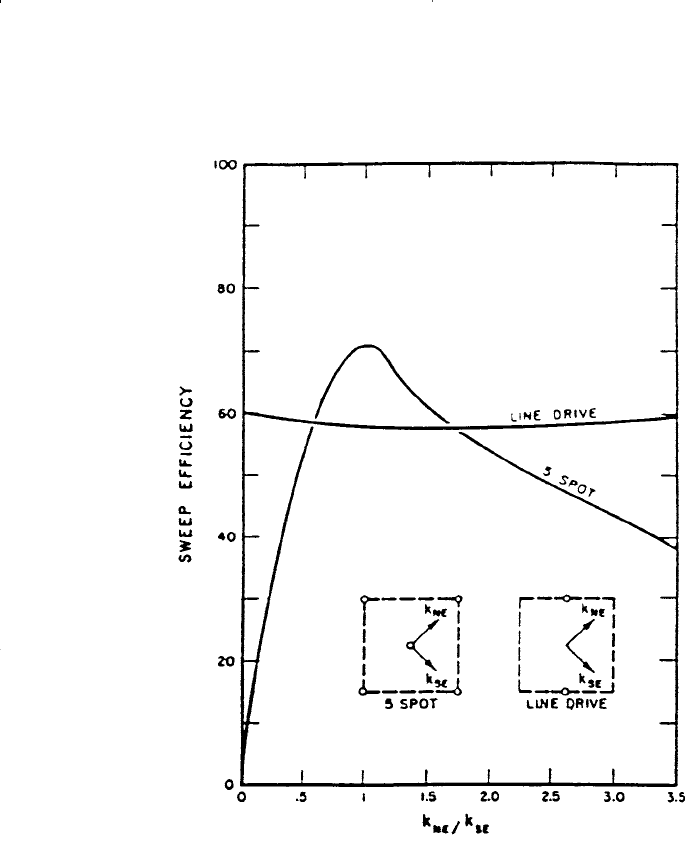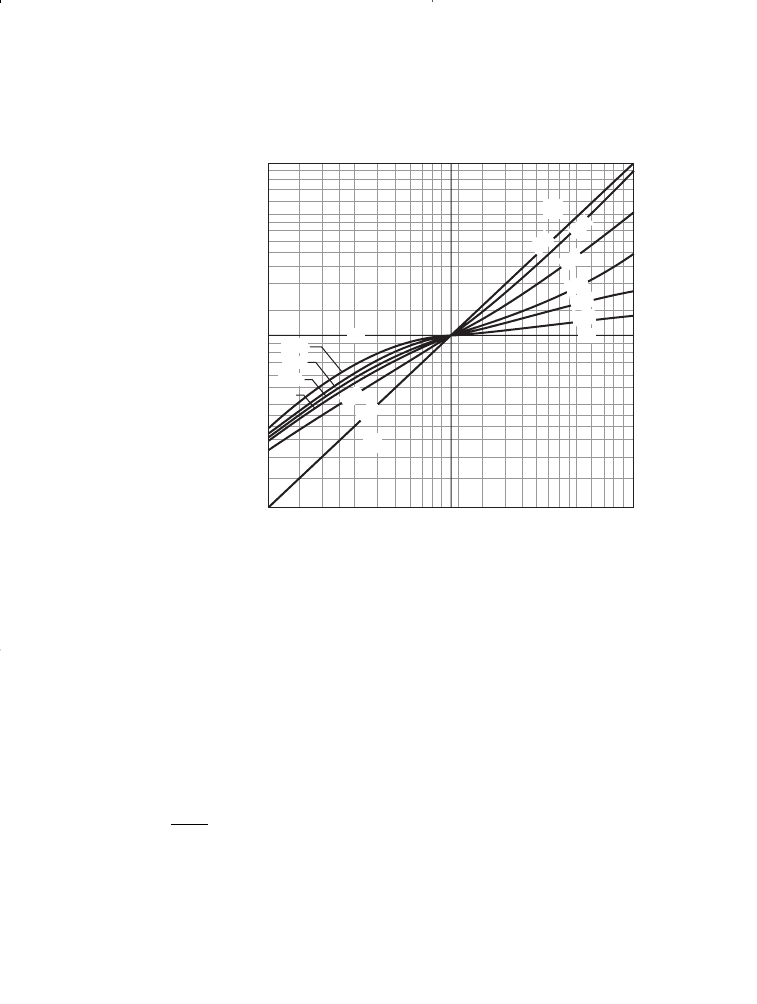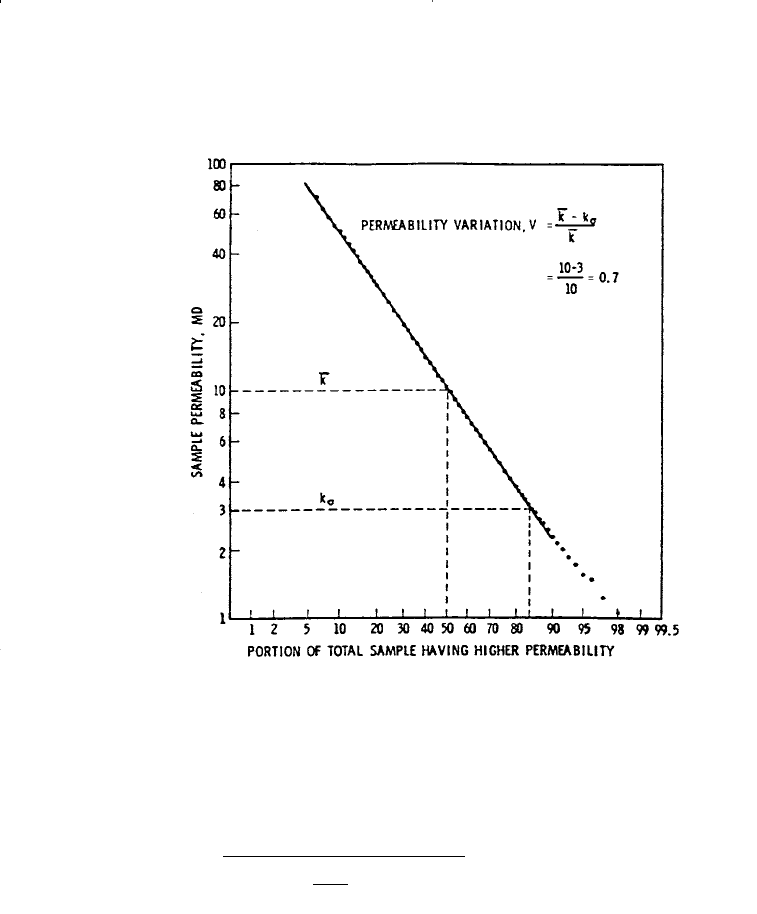Tarek Ahmed. Reservoir engineering handbook
Подождите немного. Документ загружается.


Column 4: Calculate E
A
from Equation 14-65 for value of W
inj
/ W
iBT
.
Column 5: Determine the values of the ratio Q
i
/Q
iBT
from Table 14-1
for each value of W
inj
/ W
iBT
in column 4.
Column 6: Obtain Q
i
by multiplying column 5 by Q
iBT
.
Column 7: The term (df
w
/dS
w
)
S
w2
is the reciprocal of column 6, i.e.,
1/Q
i
.
Column 8: Determine the value of S
w2
from the plot of df
w
/dS
w
vs. S
w
as given in Figure 14-38.
Column 9: Calculate the value of f
w2
that corresponds to each value of
S
w2
in column 8 by using Equation 14-24 or Figure 14-37.
Column 10: Calculate the average water saturation in the swept area
by applying Equation 14-45.
Column 11: Calculate the displacement efficiency E
D
by using Equation
14-10 for each value of in column 10.
Column 12: Calculate cumulative oil production N
p
by using Equation
14-53.
Column 13: Calculate the cumulative water production W
p
from Equa-
tion 14-53.
Column 14: Calculate the surface water-oil ratio WOR
s
from Equation
14-70.
Column 15: Calculate the oil flow rate Q
o
by using Equation 14-55.
Column 16: Determine the water flow rate Q
w
by multiplying column 14
by column 15.
Results of the above waterflooding calculations are expressed graphi-
cally in Figure 14-39.
S
w2
S
w
2
958 Reservoir Engineering Handbook
Reservoir Eng Hndbk Ch 14 2001-10-25 17:38 Page 958

Figure 14-39. Performance curves for Example 14-11.
Note that all the areal sweep efficiency correlations that have been pre-
sented thus far are based on idealized cases with severe imposed assump-
tions on the physical characteristics of the reservoir. These assumptions
include:
• Uniform isotropic permeability distribution
• Uniform porosity distribution
• No fractures in reservoir
• Confined patterns
• Uniform saturation distribution
• Off-pattern wells
To understand the effect of eliminating any of the above assumptions on
the areal sweep efficiency, it has been customary to employ laboratory
models to obtain more generalized numerical expressions. However, it is
virtually impossible to develop a generalized solution when eliminating
all or some of the above assumptions.
Landrum and Crawford (1960) have studied the effects of directional
permeability on waterflood areal sweep efficiency. Figures 14-40 and 14-
41 illustrate the impact of directional permeability variations on areal
sweep efficiency for a line drive and five-spot pattern flood.
Principles of Waterflooding 959
Reservoir Eng Hndbk Ch 14 2001-10-25 17:38 Page 959

Figure 14-40. Effect of directional permeability on E
A
. (Permission to publish by
the Society of Petroleum Engineers.)
Two key elements affect the performance of waterflooding that must
be included in recovery calculations: (1) Water injection rate, i.e., fluid
injectivity, and (2) Effect of initial gas saturation on the recovery perfor-
mance.
These key elements are discussed next.
960 Reservoir Engineering Handbook
Reservoir Eng Hndbk Ch 14 2001-10-25 17:38 Page 960

Figure 14-41. Effect of directional permeability on E
A
. (Permission to publish by
the Society of Petroleum Engineers.)
Fluid Injectivity
Injection rate is a key economic variable that must be considered when
evaluating a waterflooding project. The waterflood project’s life and, con-
sequently, the economic benefits will be directly affected by the rate at
which fluid can be injected and produced. Estimating the injection rate is
also important for the proper sizing of injection equipment and pumps.
Although injectivity can be best determined from small-scale pilot floods,
empirical methods for estimating water injectivity for regular pattern
Principles of Waterflooding 961
Reservoir Eng Hndbk Ch 14 2001-10-25 17:38 Page 961

floods have been proposed by Muskat (1948) and Deppe (1961). The
authors derived their correlations based on the following assumptions:
• Steady-state conditions
• No initial gas saturation
• Mobility ratio of unity
Water injectivity is defined as the ratio of the water injection to the
pressure difference between the injector and producer, or:
where I = injectivity, bbl/day/psi
i
w
= injection rate, bbl/day
∆P = difference between injection pressure and producing well
bottom hole flowing pressure.
When the injection fluid has the same mobility as the reservoir oil
(mobility ratio M = 1), the initial injectivity at the start of the flood is
referred to as I
base
, or:
where i
base
= initial (base) water injection rate, bbl/day
∆P
base
= initial (base) pressure difference between injector and
producer
For a five-spot pattern that is completely filled with oil, i.e., S
gi
= 0,
Muskat (1948) proposed the following injectivity equation:
or
i
P
hkk
d
r
ro
o
w
∆
=
−
(
)
base
14 - 72
0 003541
0 619
.
ln .µ
I
hkk P
d
r
ro
o
w
base
base
14 - 71=
−
(
)
0 003541
0 619
.
ln .
∆
µ
I
i
P
base
base
base
=
∆
I
i
P
w
=
∆
962 Reservoir Engineering Handbook
Reservoir Eng Hndbk Ch 14 2001-10-25 17:38 Page 962

where i
base
= base (initial) water injection rate, bbl/day
h = net thickness, ft
k = absolute permeability, md
k
ro
= oil relative permeability as evaluated at S
wi
∆P
base
= base (initial) pressure difference, psi
d = distance between injector and producer, ft
r
w
= wellbore radius, ft
Several studies have been conducted to determine the fluid injectivity
at mobility ratios other than unity. All of the studies concluded the fol-
lowing:
• At favorable mobility ratios, i.e., M < 1, the fluid injectivity declines as
the areal sweep efficiency increases.
• At unfavorable mobility ratios, i.e., M > 1, the fluid injectivity increas-
es with increasing areal sweep efficiency.
Caudle and Witte (1959) used the results of their investigation to develop
a mathematical expression that correlates the fluid injectivity with the
mobility ratio and areal sweep efficiency for five-spot patterns.
The correlation may only be used in a liquid-filled system, i.e., S
gi
= 0.
The authors presented their correlation in terms of the conductance ratio γ,
which is defined as the ratio of the fluid injectivity at any stage of the
flood to the initial (base) injectivity, i.e.:
Caudle and Witte presented the variation in the conductance ratio with
EA and M in graphical form as shown in Figure 14-42. Note again that if
an initial gas is present, the Caudle-Witte conductance ratio will not be
applicable until the gas is completely dissolved or the system becomes
liquid filled (fill-up occurs). The two possible scenarios for the practical
use of Equation 14-73 follow:
γ
γ
=
(
)
=
(
)
Fluid injectivity at any stage of the flood
Base initial fluid injectivity
14 - 73
base
i
P
i
P
w
∆
∆
Principles of Waterflooding 963
Reservoir Eng Hndbk Ch 14 2001-10-25 17:38 Page 963

Figure 14-42. Conductance ratio curve. (Permission to publish by the Society of
Petroleum Engineers.)
Scenario 1: Constant Injection Pressure and Variable Injection Rate
At constant injection pressure, i.e., ∆P
base
= ∆P, the conductance ratio
as expressed by Equation 14-73 can be written as:
or
where i
w
= Water injection rate, bbl/day
i
base
= Base (initial) water injection rate, bbl/day
ii
w
=
(
)
γ
base
14 - 74
γ=
i
i
w
base
Conductance Ratio, ⌼
Mobility Ratio
0.1
0.3
0.5
0.7
1.0
0.9
0.9
.1
1
10
.1 1 10
0
0
1.0
E
A
0.1
0.3
0.5
0.7
E
A
964 Reservoir Engineering Handbook
Reservoir Eng Hndbk Ch 14 2001-10-25 17:38 Page 964

Scenario 2: Constant Injection Rate and Variable Injection Pressure
When the water injection rate is considered constant, i.e., i
w
= i
base
, the
conductive ratio is expressed as:
or
where ∆P
base
= initial (base) pressure difference, psi
∆P = pressure difference at any stage of flood, psi
The usefulness of the conductance ratio in determining the pressure and
injectivity behavior of the five-spot system can be best described by the
following example.
Example 14-12
Estimate the water-injection rate for the waterflood in Example 14-11
at 60,000 and 144,230 bbl of water injected. Assume that the pressure
between the injector and producer will remain constant at 3000 psi.
Solution
Step 1. Calculate the distance between the injector and producer as
shown in Figure 14-43, to give:
dft=
(
)
+
(
)
=660 660 933
22
∆
∆
P
P
=
(
)
base
14 - 75
γ
γ=
∆
∆
P
P
base
Principles of Waterflooding 965
Reservoir Eng Hndbk Ch 14 2001-10-25 17:38 Page 965

Figure 14-43. Forty-acre, five-spot spacing.
Step 2. Calculate the initial (base) injection rate from Equation 14-71:
Step 3. Notice that the cumulative water injected of 60,000 bbl is less
than the amount of cumulative water injected at breakthrough of
103,020 bbl; therefore, M = 0.8 (remains constant until break-
through) and E
A
from Equation 14-63 is:
i bbl day
w
=
(
)
(
)
(
)
(
)
(
)
−
=
0 003541 5 31 5 1 3000
1
933
1
0 619
269 1
..
ln .
./
966 Reservoir Engineering Handbook
Reservoir Eng Hndbk Ch 14 2001-10-25 17:38 Page 966

Step 4. Calculate the conductance ratios from Figure 14-42, to give
γ = 0.92.
Step 5. Calculate the water-injection rate when the cumulative water
injected reaches 60,000 bbl from Equation 14-74:
Step 6. After breakthrough when the cumulative water injected reaches
144,230 barrels of water, the average water saturation in the
swept area is 59% (see Example 14-11), or
= 0.59.
Step 7. Determine the water relative permeability k
rw
at 0.59 water sat-
uration (data of Example 14-11), to give k
rw
= 0.45.
Step 8. Calculate the mobility ratio after breakthrough when W
inj
=
144,230 from Equation 14-62:
Step 9. Calculate the areal sweep efficiency when W
inj
= 144,230 from
Equation 14-65: E
A
= 0.845.
Step 10. Determine the conductance ratio from Figure 14-42: γ = 0.96.
Step 11. Calculate the water injection rate from Equation 14-76:
i
w
= (269.1) (0.96) = 258.3 bbl/day
M ==
045
1
1
05
09
.
.
.
S
w2
i bbl day
w
=
(
)
(
)
=269 1 0 92 247 6.. . /
E
A
=
(
)
−
(
)
=
60 000
310 320 0 563 0 10
0 418
,
,..
.
Principles of Waterflooding 967
Reservoir Eng Hndbk Ch 14 2001-10-25 17:38 Page 967
